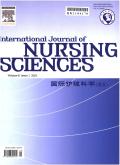Efficacy and safety of exercise rehabilitation in the vulnerable phase in patients with acute decompensated heart failure: A systematic review and meta-analysis
IF 3.1
3区 医学
Q1 NURSING
引用次数: 0
Abstract
Objectives
This study aimed to assess the impact of exercise rehabilitation during the vulnerable period on cardiac recovery (CR) outcomes in patients with acute decompensated heart failure (ADHF).
Methods
Multiple databases including PubMed, Web of Science, Embase, the Cochrane Library, CINAHL, China National Knowledge Infrastructure (CNKI), Chinese Science and Technology Periodical Database (VIP), Wanfang database, SinoMed, ClinicalTrials.gov, and American Heart Association (AHA) and European Society of Cardiology (ESC) were searched for RCTs on exercise rehabilitation in ADHF patients’ vulnerable period from inception to April 2, 2025. The risk of bias was assessed with Cochrane Risk of Bias 2.0, and data were analyzed in RevMan 5.3.
Results
A total of seven RCTs involving 946 patients were included. The results demonstrated that exercise rehabilitation training during the vulnerable period in patients with ADHF significantly increased the 6-min walk test distance (6-MWTD) (SMD = 0.37; 95 %CI: 0.09, 0.65; P = 0.01), short physical performance battery (SPPB) score (MD = 1.26; 95 %CI: 0.82, 1.70; P < 0.001) and peak oxygen consumption (VO2peak) (SMD = 1.43; 95 %CI: 0.53, 2.34; P = 0.002), improved quality of life (QoL) (SMD = 0.85; 95 %CI: 0.07, 1.64, P = 0.03), reduced depression score (MD = −0.73; 95 %CI: 1.27, −0.18; P = 0.009), frailty (MD = −0.22; 95 %CI: −0.48, 0.05; P = 0.11), and decreased 6-month all-cause readmission (OR = 0.67; 95 %CI: 0.49, 0.91; P = 0.01). However, no statistically significant differences were observed between the two groups in left ventricular ejection fraction (LVEF) (MD = 0.96; 95 %CI: −1.84, 3.77; P = 0.50), 6-month heart failure (HF)-related readmission (OR = 1.01; 95 %CI: 0.66, 1.53; P = 0.98), and all-cause mortality (OR = 0.63; 95 %CI: 0.18, 2.24; P = 0.47). There were no adverse events reported.
Conclusions
Exercise rehabilitation during the vulnerable phase improves exercise tolerance, QoL, and depressive symptoms while reducing 6-month all-cause readmissions in ADHF patients, with no reported adverse events. Although trends toward improved LVEF, HF-related readmissions, and all-cause mortality were observed. Large-scale, high-quality studies are warranted to explore individualized responses and long-term outcomes.
急性失代偿性心力衰竭患者易损期运动康复的疗效和安全性:一项系统综述和荟萃分析
目的探讨易损期运动康复对急性失代偿性心力衰竭(ADHF)患者心脏恢复(CR)结局的影响。方法检索PubMed、Web of Science、Embase、Cochrane Library、CINAHL、中国知网(CNKI)、中国科技期刊数据库(VIP)、万方数据库、中国医学信息网(sinmed)、ClinicalTrials.gov、美国心脏协会(AHA)和欧洲心脏病学会(ESC)等数据库,检索自ADHF成立至2025年4月2日ADHF患者易损期运动康复的rct。偏倚风险采用Cochrane risk of bias 2.0进行评估,数据采用RevMan 5.3进行分析。结果共纳入7项rct, 946例患者。结果表明:ADHF患者易损期运动康复训练显著提高6 min步行测试距离(6-MWTD) (SMD = 0.37;95% ci: 0.09, 0.65;P = 0.01),短物理性能电池(SPPB)评分(MD = 1.26;95% ci: 0.82, 1.70;P & lt;0.001)和峰值耗氧量(VO2peak) (SMD = 1.43;95% ci: 0.53, 2.34;P = 0.002),改善生活质量(QoL) (SMD = 0.85;95% CI: 0.07, 1.64, P = 0.03),抑郁评分降低(MD = - 0.73;95% ci: 1.27,−0.18;P = 0.009),虚弱(MD = - 0.22;95% ci:−0.48,0.05;P = 0.11), 6个月全因再入院率降低(OR = 0.67;95% ci: 0.49, 0.91;P = 0.01)。两组左室射血分数(LVEF)差异无统计学意义(MD = 0.96;95% ci:−1.84,3.77;P = 0.50), 6个月心力衰竭(HF)相关再入院(OR = 1.01;95% ci: 0.66, 1.53;P = 0.98),全因死亡率(OR = 0.63;95% ci: 0.18, 2.24;P = 0.47)。无不良事件报告。结论易损期运动康复可改善ADHF患者的运动耐量、生活质量和抑郁症状,同时减少6个月全因再入院,无不良事件报告。虽然LVEF有改善的趋势,但hf相关的再入院率和全因死亡率均有所提高。有必要进行大规模、高质量的研究,以探索个性化的反应和长期结果。
本文章由计算机程序翻译,如有差异,请以英文原文为准。
求助全文
约1分钟内获得全文
求助全文
来源期刊

International Journal of Nursing Sciences
Nursing-Nursing (all)
CiteScore
6.10
自引率
2.60%
发文量
408
审稿时长
25 days
期刊介绍:
This journal aims to promote excellence in nursing and health care through the dissemination of the latest, evidence-based, peer-reviewed clinical information and original research, providing an international platform for exchanging knowledge, research findings and nursing practice experience. This journal covers a wide range of nursing topics such as advanced nursing practice, bio-psychosocial issues related to health, cultural perspectives, lifestyle change as a component of health promotion, chronic disease, including end-of-life care, family care giving. IJNSS publishes four issues per year in Jan/Apr/Jul/Oct. IJNSS intended readership includes practicing nurses in all spheres and at all levels who are committed to advancing practice and professional development on the basis of new knowledge and evidence; managers and senior members of the nursing; nurse educators and nursing students etc. IJNSS seeks to enrich insight into clinical need and the implications for nursing intervention and models of service delivery. Contributions are welcomed from other health professions on issues that have a direct impact on nursing practice.
 求助内容:
求助内容: 应助结果提醒方式:
应助结果提醒方式:


